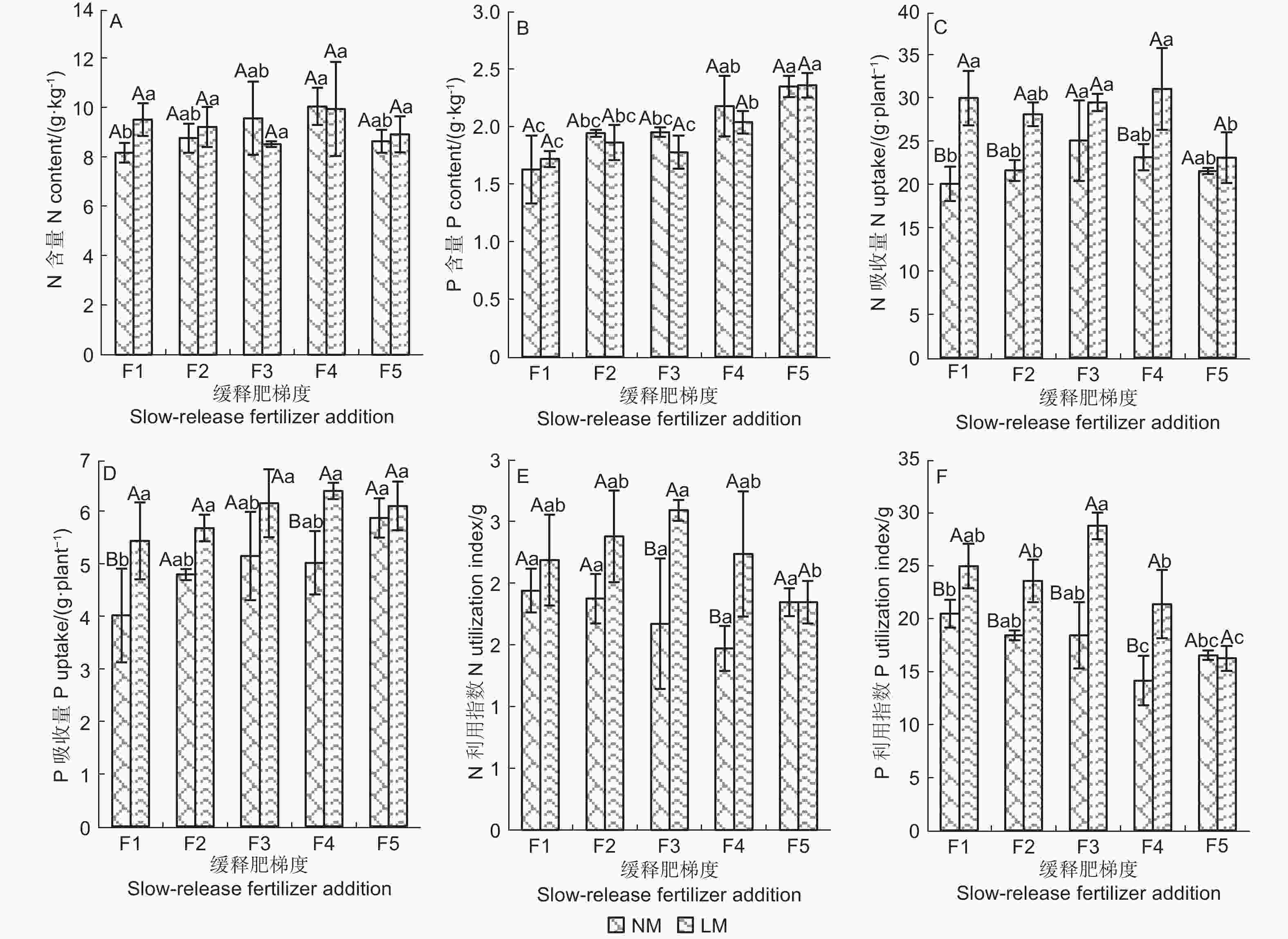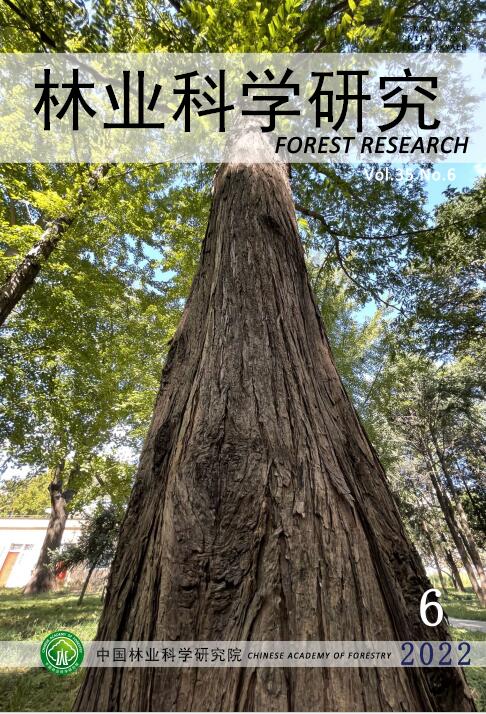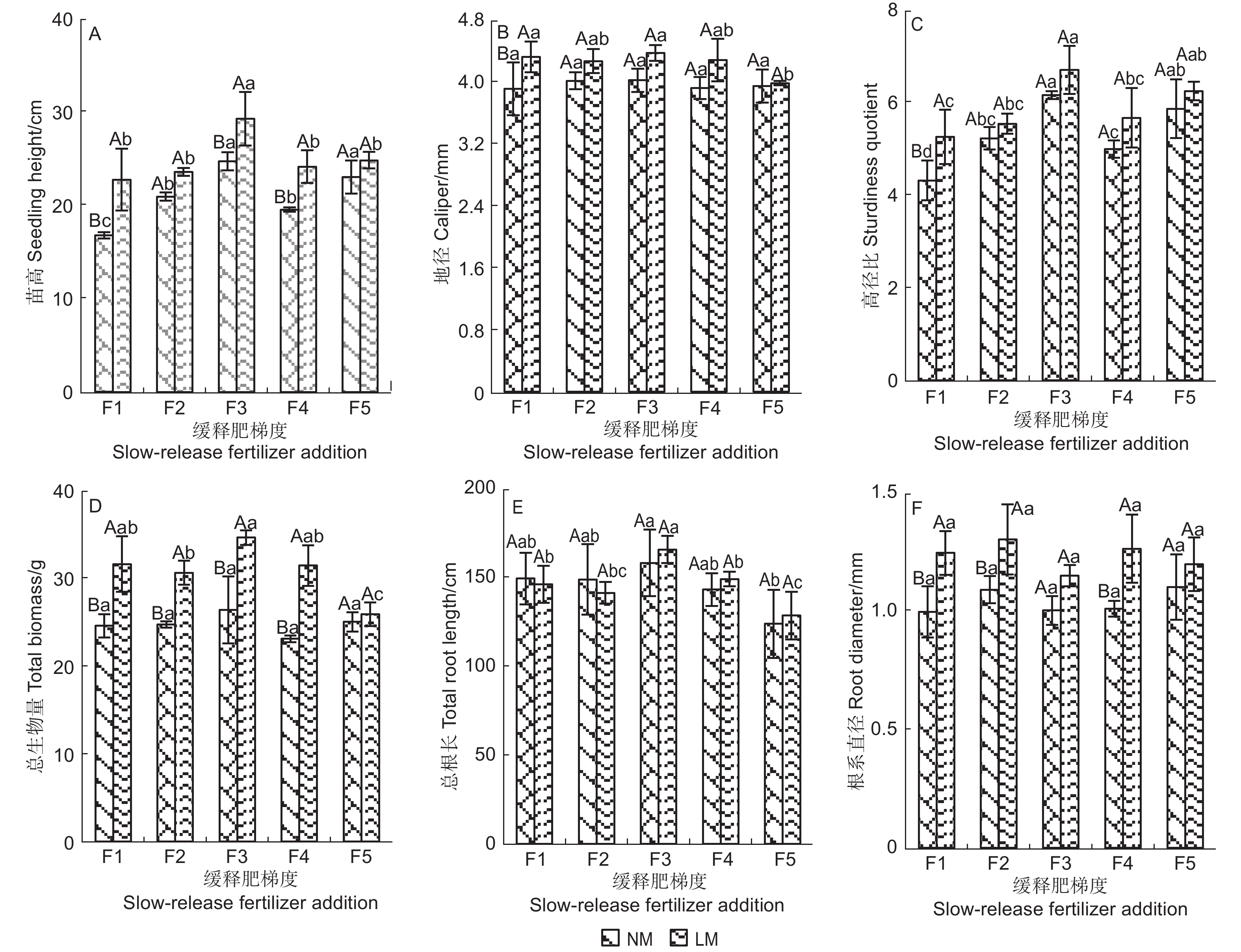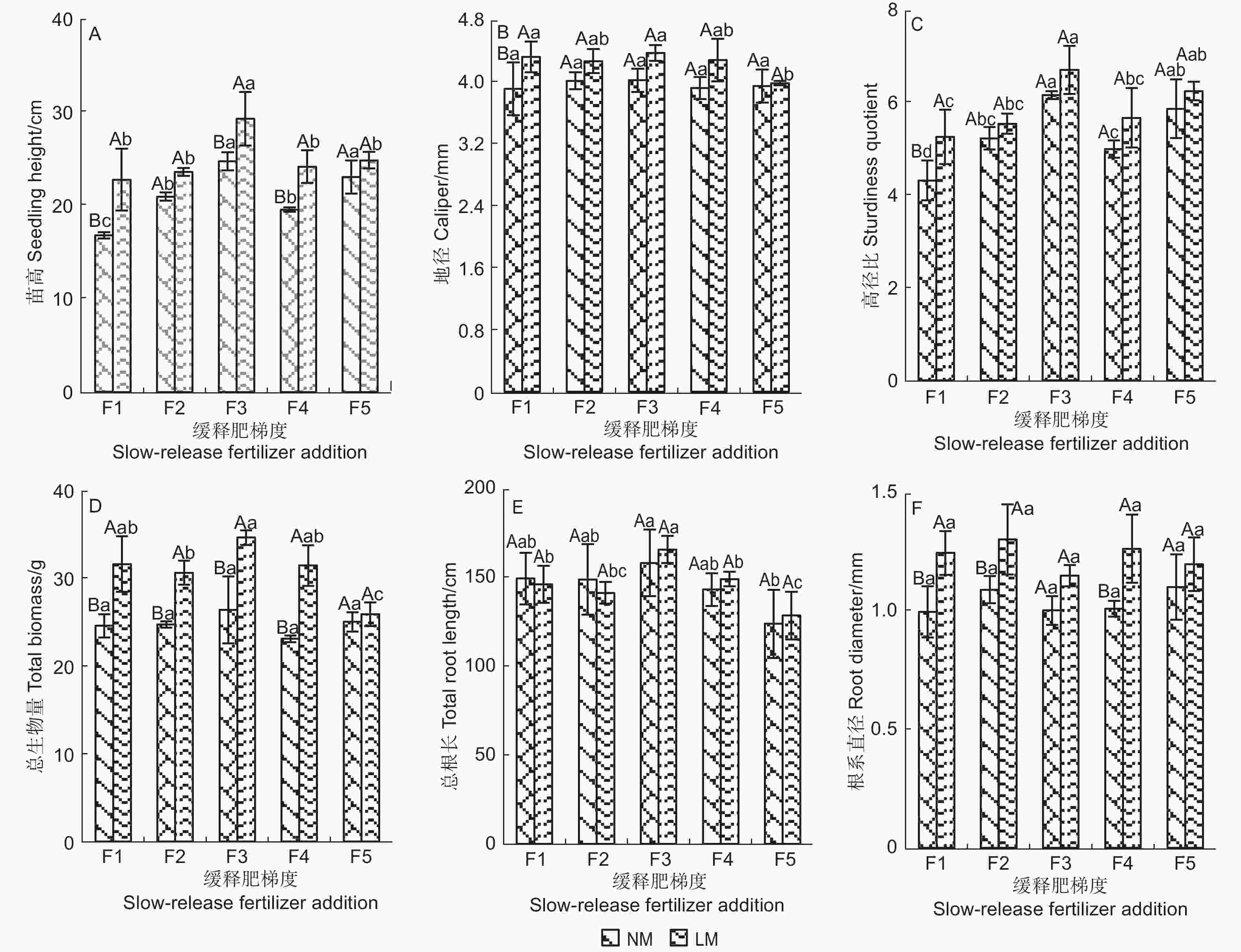-
土壤有效养分和菌根真菌及其互作对植物生长、根系发育和养分吸收等有重要影响。土壤中外生菌根真菌侵染植物根系,与植物根结合形成的共生体-菌根,能增强植物对土壤中氮和磷等养分的吸收利用,进而促进植物的生长发育和提高植物的抗逆性[1-4]。外生菌根可从根际土壤中吸收NH4+和NO3−这2种氮素形态,且可以吸收土壤中游离的氨基酸,将其转运给宿主植物[5-7]。在菌根共生体中,宿主获取的所有磷素几乎全部来自共生真菌[8],接种菌根真菌使宿主从土壤中吸收的磷成倍增加,即使在土壤极度缺磷时,菌根仍能吸收磷[9-10]。菌根促进其共生植物磷吸收的现象,在各种林木及生长环境中被广泛地证实[11]。已有研究表明,施肥和接种菌根菌及其交互作用对油松(Pinus tabuliformis Carr.)、马尾松(P. massoniana Lamb.)、樟子松(P. sylvestris L. var. mongolica Litv.)和刺槐(Robinia pseudoacacia L.)等生长和生理等指标有显著促进作用。
赤皮青冈(Cyclobalanopsis gilva Oerst.)为壳斗科(Fagaceae)青冈属(Cyclobalanopsis Oerst.)常绿阔叶大乔木,是我国南方地区重要的珍贵用材和生态修复树种,造林用苗需求量较大。近几年,不同学者从基质配比、不同N/P比缓释肥加载等方面对赤皮青冈优质容器苗培育展开研究,结果表明,缓释肥和N/P配比施肥等不同施肥方式均对赤皮青冈幼苗生长有促进作用,同时也有效提高了赤皮青冈苗木质量[12-15];但相对于壳斗科其它树种,赤皮青冈1年生容器苗发芽不整齐,幼苗生长慢仍是其容器苗培育过程中存在的主要问题。壳斗科植物是典型的外生菌根树种,对外生菌根具有较强的依赖性,自然条件下菌根多样性丰富[16],白栎(Quercus fabri Hance)、麻栎(Q. acutissima Carruth.)和青冈栎(C. glauca Oerst.)等壳斗科树种均表现出积极的菌根效应[16-18],但目前关于赤皮青冈接种菌根菌的相关研究尚少,菌根化育苗能否促进赤皮青冈幼苗生长尚不清楚,不同缓施肥条件下接种菌根菌对赤皮青冈幼苗的生长和养分利用效率的影响是否不同也有待研究。本文以赤皮青冈1年生容器苗为试验材料,研究不同缓释肥添加量和接种菌根菌条件下容器苗的生长和养分吸收利用差异,以期为赤皮青冈容器苗合理施肥和菌根化育苗提供科学依据。
-
试验在浙江省庆元县实验林场(119°01′25″ E,27°38′48″ N)育苗基地钢构大棚内进行,该地属亚热带季风气候,温暖湿润,四季分明,海拔510 m,年均气温17.6 ℃,年均降水量 1721.3 mm,无霜期245 d。供试材料为庆元林木良种基地采集的赤皮青冈种子所育的实生苗。育苗基质为泥炭、谷壳和珍珠岩(体积比为6:1:3)。泥炭pH值为5.8,全N、全P和全K含量分别为14.2、0.7和2.7 g·kg−1。谷壳和珍珠岩在育苗期间主要发挥疏松基质作用,谷壳基本无分解。育苗容器规格为4.5 cm × 10 cm(直径 × 高)的无纺布网袋。所用菌种彩色豆马勃(Pisolithus tinctorius (Pers.) Coker & Couch)从北京百欧博伟生物购买,由中国林业科学研究院亚热带林业研究所培养繁殖。所用缓释肥为美国辛普劳公司生产的爱贝施(Apex)长效控释肥,其全N含量为180 g·kg−1,有效P含量为60 g·kg−1,全K含量为120 g·kg−1,肥效6—7个月。
-
试验采用裂区试验设计,主区为菌根菌处理,分为接种(LM)和不接种(NM)2个处理。副区为缓释肥加载(F)处理,试验设置5个缓释肥添加梯度,分别为F1(1.50 kg·m−3)、F2(2.25 kg·m−3)、F3(3.00 kg·m−3)、F4(3.75 kg·m−3)和F5(4.50 kg·m−3)。2021年4月中旬,将大棚中培育的赤皮青冈芽苗移栽至5种不同施肥梯度的育苗容器中,每个梯度移栽300株,分区块放置在育苗盘中(每盘64株)进行培养。7月上旬在赤皮青冈容器苗分级分盘育苗前,从每个施肥梯度中随机选取苗高约10 cm的容器苗60株,分成两组,一组接种,一组不接种(即对照),每组30株(3次重复,每重复10株)。采用育苗容器中间部位注射方式,对接种组每株容器苗接种10 mL彩色豆马勃(浓度36.28 mg·mL−1)。接种和不接种容器苗均放置在有间隔的育苗盘中进行培育,不同处理容器苗之间保持1 m以上间隔。容器苗按育苗基地常规育苗流程进行喷灌和遮阳等生产管理。
-
2021年11月中旬(生长季末),收获所有试验苗木,分别用钢卷尺和游标卡尺测量容器苗的苗高和地径,同时以每重复小区10株为单元进行菌根侵染率、生物量和养分测定。随机选取容器苗细根根段,以形成外生菌根的根段数占观察的总根段数的百分比作为菌根侵染率[19]。将植株根、茎、叶各器官均置于105 ℃烘箱中杀青30 min,再在60 ℃下烘至恒质量,测定其各器官干质量。称取各器官干样,采用H2SO4-H2O2法消煮,分别采用凯氏定氮法和ICP-OES光谱仪(Vista-Mpx,美国Varian公司)测定其氮磷含量。通过根系扫描设备(Expression 10 000XL 1.0,Canada)对不同处理后的根系进行扫描,利用WinRHIZO根系分析软件分析获得根长和根系直径数据。
-
苗木高径比为苗高(cm)与地径(cm)的比值,N和P含量及吸收量计算参照文献[20],养分利用指数(INU)采用每单位叶片养分所占苗木生物量来衡量[21]。
N、P含量=(叶N、P含量 × 叶干质量 + 茎N、P含量 × 茎干质量 + 根N、P含量 × 根干质量)/(叶干质量 + 茎干质量 + 根干质量)
N、P吸收量= N、P含量 × (叶干质量 + 茎干质量 + 根干质量)
N、P利用指数=(叶干质量 + 茎干质量 + 根干质量)/ 叶N、P含量
采用EXCEL 2019进行数据处理及相关图形制作,利用SPSS 20.0软件进行双因素方差分析和Duncan's检验(α=0.05)。
-
试验结果显示:LM处理的1年生赤皮青冈容器苗苗高、地径、高径比、总生物量、总根长和根系直径等生长性状相比NM分别增加18.70%、7.16%、10.75%、24.55%、1.02%和18.47%(表1),N含量、N吸收量和N利用指数分别增加了2.04%、27.10%和27.67%,P吸收量和P利用指数分别增加19.72%和30.52%。除P含量降低2.94%外,LM处理对苗木生长性状和养分状况均有促进作用,其中,总生物量、养分吸收量和利用指数增幅较大(≥20%)。从变异系数看,LM处理的苗高、高径比、总根长、N含量、P含量、P吸收量等变异程度相比NM下降0.13%~7.19%,其一致性有所提高;地径、总生物量、根系直径、N吸收量、N利用指数和P利用指数等变异程度增加0.14%~4.80%,其一致性有所降低。
性状
Trait接种处理
Treatment of mycorrhizal fungiF值
F Value不接种
Non-inoculated
(NM)接种
Inoculated
(LM)菌根菌
Mycorrhizal
(M)不同缓释肥添加梯度
Slow-release fertilizer
addition(F)菌根菌 × 缓释肥添加
(M × F)苗高 Seedling height/cm 20.906±2.959 24.816±2.979 41.434** 15.770** 1.518 地径 Caliper/mm 3.953±0.182 4.236±0.203 16.392** 1.193 0.916 高径比 Sturdiness quotient 5.293±0.741 5.862±0.669 13.544** 13.927** 0.521 总生物量 Total biomass/g 24.728±1.925 30.799±3.361 74.160** 5.280** 3.809* 总根长 Total root length/cm 144.456±18.435 145.931±14.571 0.091 5.382** 0.356 根系直径 Root diameter/mm 1.034±0.088 1.225±0.111 26.401** 1.095 0.668 N含量 N content/(g·kg−1) 9.034±0.992 9.218±1.000 0.293 1.680 1.286 P含量 P content /(g·kg−1) 2.009±0.296 1.950±0.259 1.083 16.967** 0.742 N吸收量 N uptake /(g·plant−1) 22.293±2.692 28.334±3.806 37.601** 3.330* 2.119 P吸收量 P uptake /(g·plant−1) 4.969±0.819 5.949±0.553 22.044** 4.405** 1.048 N利用指数 N utilization index/g 1.760±0.296 2.247±0.381 18.481** 1.280 2.160 P利用指数 P utilization index/g 17.616±2.703 22.993±4.631 55.323** 14.852** 5.831** 注:**和*分别表示P<0.01和P<0.05水平显著。下同。
Notes: **, * mean significant differences among the values at 0.01 and 0.05 level, respectively.The same blow.Table 1. Variance analysis of growth traits and nutrient status of C. gilva container seedlings
方差分析表明:接种处理(M)对赤皮青冈容器苗苗高、地径、高径比、总生物量和根系直径等生长性状,N、P吸收量和N、P利用指数等养分状况有极显著影响。不同缓释肥添加梯度(F)对赤皮青冈容器苗苗高、高径比、总生物量和总根长等生长性状及N吸收量、P含量、P吸收量和P利用指数等养分状况有显著或及显著影响。接种菌根菌和缓释肥添加(M × F)仅对赤皮青冈容器苗总生物量和P利用指数有显著或极显著影响。
-
赤皮青冈容器苗苗高、地径、高径比、总生物量和根系直径等生长性状在不同缓释肥添加梯度下均表现为LM>NM(图1A、B、C、D、F),可见接种菌根菌对不同缓释肥梯度下容器苗的生长有较好的促进作用。总根长F1和F2梯度下表现为NM>LM,F3、F4和F5梯度下表现为LM>NM(图1E),高肥力水平下总根长表现出积极的菌根效应,但差异不显著。NM处理下,赤皮青冈容器苗苗高、地径、高径比、总生物量和总根长呈先升高后降低趋势,F3梯度最高,各指标比相应最小值分别高47.52%、2.82%、42.68%、14.20%和27.63%,苗高和高径比F3与F5梯度无显著差异,但显著高于F1、F2和F4;总根长F3梯度显著高于F5(图1E);地径、总生物量和根系直径各梯度间无显著差异(图1B、D、F)。可见缓释肥梯度对苗高、高径比和总根长影响较大,对地径、总生物量和根系直径影响较小。LM处理下,苗高、地径、高径比、总生物量和总根长等性状随缓释肥添加量增加而变化的总体规律不变,仍以F3梯度最高,各指标比相应最小值分别高28.72%、9.76%、27.46%、33.72%和28.95%。接种菌根菌后,不同施肥梯度间苗高和高径比差异缩小,地径、总生物量和总根长差异增大。
-
接种菌根菌后赤皮青冈容器苗养分利用效率总体增加,但不同养分指标表现不同。N含量和P含量不同缓释肥添加梯度下LM和NM无显著差异,N吸收量、P吸收量和N利用指数均为LM>NM,P利用指数F1~F4梯度LM>NM且差异显著(图2A~F)。无论是否接种菌根菌,随缓释肥添加量增加,P含量和P吸收量整体呈增加趋势;NM处理下N含量和N吸收量随缓释肥添加量增加呈先增加后降低趋势,N利用指数、P利用指数呈先降低后增加的趋势;LM处理下N利用指数、P利用指数变化趋势正好相反,呈先增加后降低趋势,N含量和N吸收量则无明显变化规律。

Figure 2. Nutrient difference of C. gilva container seedlings under slow-release fertilizer addition and inoculation of mycorrhizal fungi
NM处理下,赤皮青冈容器苗N含量和N吸收量分别以F4和F3梯度最高,比相应最小值分别高22.88%和24.72%(图2A、C,P<0.05);P含量和P吸收量以F5梯度最高,比相应最小值分别高44.31%和46.18%(图2B、D,P<0.05); N利用指数F1梯度最高,但不同施肥梯度间差异不显著(图2E);P利用指数F1梯度最高,比最小的F4梯度高44.54%(图2F,P<0.05)。相对而言,施肥梯度对容器苗P利用效率的影响更大。LM处理下,容器苗N含量和N吸收量均以F4梯度最高,P含量和P吸收量分别以F5和F4梯度最高,不同施肥梯度间N含量和P吸收量无显著差异,N吸收量F4梯度比F5高34.31%(P<0.05),P含量F5梯度比F1高37.33%(P<0.05);N利用指数F1~F4梯度间无显著差异,F5梯度最小(图2E、F)。接种菌根菌后,不同施肥梯度间N含量、P含量和P吸收量差异缩小,N吸收量、N利用指数和P利用指数差异增大。
-
NM处理下,赤皮青冈容器苗生长性状和养分状况间的联系不紧密,仅苗高与P吸收量、总生物量与P利用指数呈显著正相关(表2),相对于N而言,P的供给水平对赤皮青冈生长影响较大。LM处理下,赤皮青冈容器苗生长性状和养分状况的关联明显增强,其中,苗高和高径比与P吸收量呈显著正相关,总生物量和总根长与N吸收量呈显著正相关,地径、总生物量和总根长与P含量呈显著或极显著负相关,而与N利用指数和P利用指数呈显著或极显著正相关。不接种赤皮青冈容器苗总根长与P含量呈负相关(r =−0.346),接种后其关系进一步增强(r =−0.524,P<0.05),意味着苗木的根营养器官较发达时,特别是菌根菌与根共生形成菌根后,苗木将体内的P含量维持在相对较低的水平,将更多的P元素用于苗木的生长,特别是增加地径(r = −0.668,P<0.01)和总生物量(r = −0.697,P<0.01)。接种后容器苗地径越大,总生物量越高,总根长越长,相应N吸收量越高,N利用指数、P利用指数越大,可见菌根的形成提高了苗木的养分利用效率。
处理
Treatment性状
Trait苗高
Seedling height地径
Caliper高径比
Sturdiness quotient总生物量
Total biomass总根长
Total root length根系直径
Root diameter不接种
Non-inoculated(NM)N含量 N content 0.154 0.133 0.117 −0.257 −0.069 −0.178 P含量 P content 0.430 0.274 0.360 0.041 −0.346 0.384 N吸收量 N uptake 0.455 0.412 0.322 0.455 0.224 −0.158 P吸收量 P uptake 0.614* 0.442 0.484 0.501 −0.111 0.335 N利用指数 N utilization index 0.001 −0.122 0.029 0.412 0.232 0.177 P利用指数 P utilization index −0.096 0.005 −0.114 0.574* 0.383 −0.095 接种
Inoculated(LM)N含量 N content −0.451 −0.275 −0.362 −0.184 −0.106 0.168 P含量 P content 0.031 −0.668** 0.326 −0.697** −0.524* −0.123 N吸收量 N uptake −0.003 0.489 −0.216 0.632* 0.619* 0.062 P吸收量 P uptake 0.557* 0.167 0.523* 0.256 0.394 −0.259 N利用指数 N utilization index 0.490 0.781** 0.187 0.770** 0.606* 0.039 P利用指数 P utilization index 0.427 0.809** 0.094 0.912** 0.803** −0.065 Table 2. Correlation analysis of growth traits and nutrient status of C. gilva container seedlings
-
接种合适的外生菌根菌能对植物的生长发育起到明显的促进作用。本研究赤皮青冈容器苗接种彩色豆马勃后,对不同缓释肥添加量下容器苗的苗高、地径、高径比、总生物量和根系直径等均有促进作用,这与对马尾松、杉木(Cunninghamia lanceolate (Lamb.)Hook.)、东北红豆杉(Taxus cuspidate Sieb.)、槲树(Quercus dentate Thunb.)、构树(Broussonetia papyrifera L'Hér. ex Vent.)等苗木研究结果一致[22-26]。接种后赤皮青冈容器苗总根长低肥力水平下(≤2.25 kg·m−3)小于不接种,高肥力水平下(≥3.75 kg·m−3)大于不接种,主要是低肥力下,菌根共生关系强,苗木减少根长而增加根粗,依靠菌丝吸收养分,而高肥力下,菌根共生关系弱,苗木增加根长生长,扩大根系分布范围增加养分吸收能力[27-28]。关于缓释肥对苗木生长和根系发育的影响,不同研究结果不尽相同。赤皮青冈容器苗苗高、生物量和根体积随着缓释肥施用量增加先升高后降低,根长和根系直径缓释肥效应较小,与吴小林等[15]关于赤皮青冈研究结果相同,其根系直径没有显著的缓释肥效应,与庞圣江等关于望天树(Parashorea chinensis Wang Hsie)和白木香(Aquilaria sinensis Spreng.)研究结果一致[29-30]。
菌根真菌能够促进植物对N、P等营养元素的吸收利用,改善植物体的营养状况,增加植物体内的养分含量,提高植物养分利用效率[27-28]。本研究接种菌根菌对赤皮青冈容器苗N、P吸收量和N、P利用指数有显著促进作用,与Hu等[27]和Bai等[28]的研究结果一致,但接种菌根菌对N、P含量无显著影响,与其研究结果不同。结合两两比较结果可见,在适宜的肥力水平下(3 kg·m−3左右),赤皮青冈容器苗N、P含量表现出一定的菌根负效应(接种低于不接种),但该肥力水平下接种菌根菌对容器苗的生长仍为促进作用,可能是接种容器苗因为菌根的存在,未在体内储存过多的养分,而是将养分更多用于干物质累积,以获得更多的生长空间[31-32]。接种后随缓释肥加载量的增加,赤皮青冈容器苗N、P利用指数呈先增加后降低趋势,与不接种正好相反,但在高缓释肥加载量时(4.5 kg·m−3),接种和不接种无显著差异,说明相对偏低的养分环境中菌根的存在改变了植株的养分利用策略[33]。
N、P元素是植物体内重要有机化合物的组成成分,多方面影响着植物的生长发育,二者在吸收利用上也存在着相互作用[34]。接种菌根菌赤皮青冈容器苗生长性状和养分状况间的相关性增强,说明接种后苗木生长对养分的变化更敏感,苗木与菌根菌之间形成较好的共生关系。结合前述分析可知,这种共生关系低肥力下更显著,高肥力下则逐渐减弱。可见培育赤皮青冈容器苗时,相对较低的肥力条件下接种菌根菌可获得较好效果。无论是否接种,不同缓释肥添加量下赤皮青冈容器苗的生长性状与P元素的关系都较密切,说明赤皮青冈育苗过程中对P元素的需求更重要。1年生赤皮青冈养分库构建差异研究也表明其培育过程中需要相对高P的缓释肥[13]。接种前N元素相关养分状况与生长性状间无显著相关性,接种后N利用指数与生长性状关联增强,主要是接种后菌根的形成促进了苗木的生长,提高了苗木对N养分的需求,使N相关养分与生长指标之间的联系更紧密[6,35]。
-
接种外生菌根菌彩色豆马勃可促进1年生赤皮青冈容器苗生长,低肥力下菌根的促生效应更显著。接种后容器苗苗高、总生物量、根系直径、N吸收量、P吸收量与N利用指数、P利用指数等增幅较大,苗高和高径比的一致性有所提高。缓释肥添加和接种菌根菌对容器苗总生物量和P利用指数有显著的互作效应。无论是否接种菌根菌,随缓释肥添加量增加,容器苗各生长性状均呈先增加后降低趋势,缓释肥添加量3 kg·cm−3时生长表现最好。接种后容器苗N、P养分利用效率明显提高,苗木的生长性状与养分状况间的相关性明显增强。基于对接种菌根菌数据的分析表明,在相对较低的肥力条件下接种菌根菌,有助于培育赤皮青冈优质苗木并节约育苗成本。
Effects of Slow-release Fertilizer Addition and Inoculation of Mycorrhizal Fungi on the Growth Traits and Nutrient Status of Cyclobalanopsis gilva Container Seedlings
- Received Date: 2022-04-12
- Accepted Date: 2022-05-27
- Available Online: 2022-12-20
Abstract:







 DownLoad:
DownLoad:
